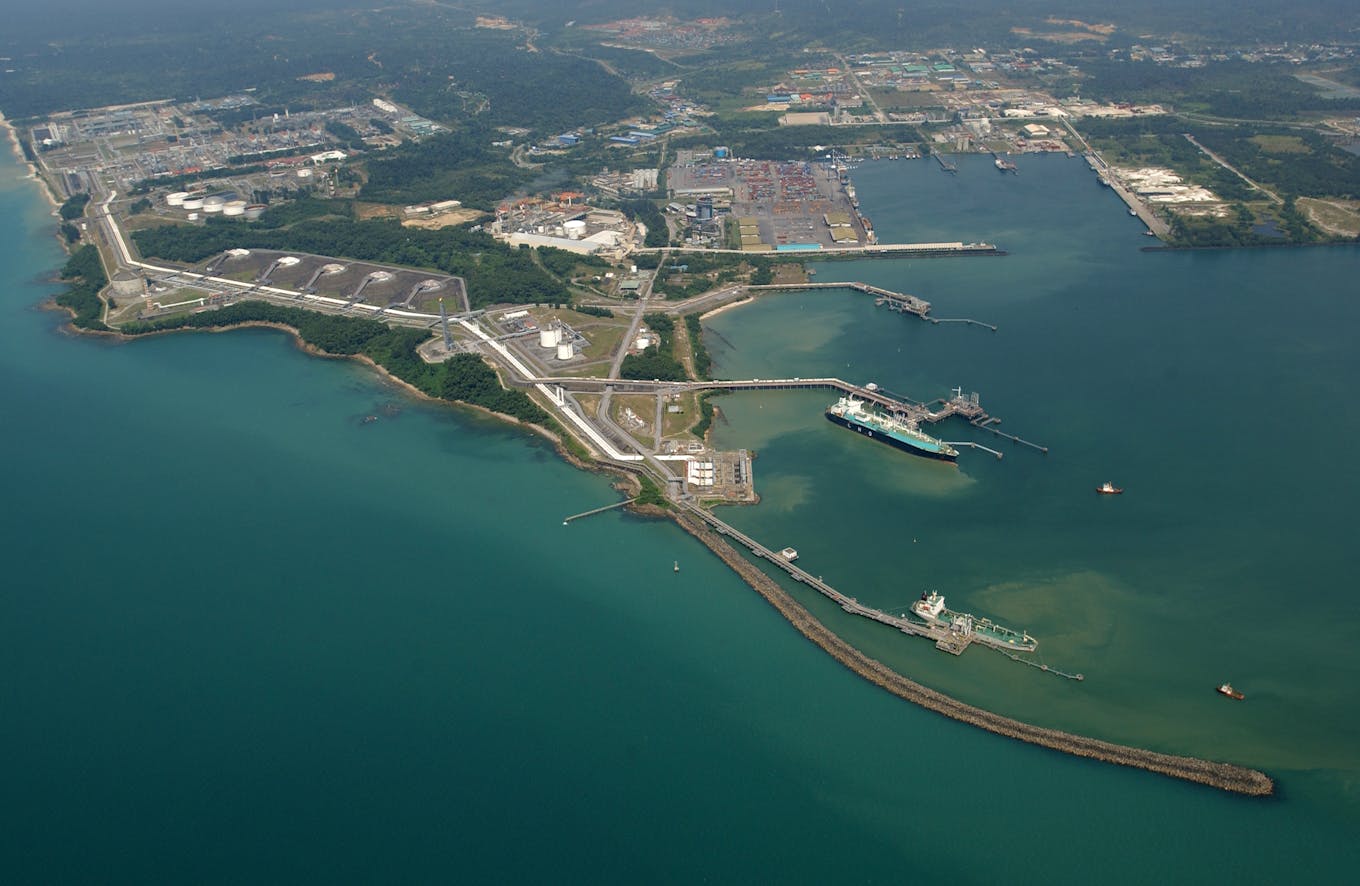As the world’s energy system shifts from fossil fuels to cleaner sources of power, there is one fossil fuel that has clung to relevance as the market transitions: natural gas.
To continue reading, subscribe to Eco‑Business.
There's something for everyone. We offer a range of subscription plans.
- Access our stories and receive our Insights Weekly newsletter with the free EB Member plan.
- Unlock unlimited access to our content and archive with EB Circle.
- Publish your content with EB Premium.
Enjoying a less troubled reputation as the least polluting fossil fuel when burned, gas has been dubbed a “bridging” fuel in the energy transition, a narrative enthusiastically told by fossil fuels companies worried about tightening climate policies and increasingly competitive sources of clean energy that cast doubt over the fuel’s long-term economic viability.
One such company is Petroliam Nasional (Petronas), Malaysia’s US$150 billion state-owned energy giant, the world’s ninth largest oil and gas company. “Natural gas is the cleanest burning fossil fuel and a complimentary fuel to address intermittency issues faced by renewables,” says Abang Yusuf Abang Puteh, the company’s vice president of liquid natural gas (LNG) assets.
This narrative is influencing policymaking at a critical time for tackling the climate crisis. Demand for gas is expected to remain resilient globally, even under energy transition scenarios that call for a rapid phase-down of fossil fuels. Decarbonisation commitments will hasten demand decline in mature markets like Europe and North America, but in Asia, which accounts for almost three-quarters of global LNG imports currently, demand is unlikely to wane.
Asia is expected to account for 60 per cent of global gas demand growth over the next three decades, and by 2050, a third of the world’s gas will be consumed by the region – up from about a fifth in 2020.
Though climate-harming impacts from the production, transport and consumption of natural gas trouble environmentalists as much as coal or oil, the fuel’s future looks relatively stable. While lawmakers in the United States consider statewide bans on natural gas connections in new buildings in response to the climate crisis, the European Union plans to label natural gas as “green” — for a limited period, if they replace dirtier fossil fuels — in its new taxonomy for sustainable finance.
Companies like Petronas, which only recently started to diversify its portfolio by investing in renewable energy, will benefit from the energy transition, as long as gas is held up as a “bridging” fuel. Malaysia is the world’s third largest export of LNG, and income from Petronas made up about a third of public revenue in 2019.
“
The dependency of the world on fossil fuel is not is easy to break. Fossil fuels still supply about 80 per cent of the world’s GDP.
Abang Yusuf Abang Puteh, vice president, LNG Assets, Petronas
In this interview, Abang was asked about the rocky path to decarbonisation, Petronas’s “aspirational” net-zero target, methane leaks, carbon capture and lobbying to push the gas agenda.
It’s a few months since the COP26 climate talks. Where does Petronas fit into the decarbonisation narrative?
We are less than two years into our journey towards net-zero carbon emissions by 2050 — we were the first oil and gas company in Asia to set a net-zero target in November last year. We’ve established Petronas Gas + New Energy [a lower carbon division set up in 2020] as we look to pursue cleaner sources of energy. The revenue we generate from our natural gas business still commands a much larger share of revenue compared to our renewables business, and gas will remain a core business for us. But we want to grow our renewables business to form at least 30 per cent of overall revenue over the next few decades in the run-up to 2050. In the nearer term, we’re aiming to grow our cleaner energy portfolio mix with a target of three gigawatts of installed renewable energy capacity by 2024, as we look to cap our overall emissions at 49.5 million tonnes of CO2 by 2024.
What is Petronas doing to reduce its considerable carbon footprint?
We’re reducing scope 1 emissions [direct emissions from the company’s own operations]. In 2021, we saved about 100,000 tonnes of CO2 equivalent. We did this in a number of ways, including flaring [the burning of excess gas during extraction] recovery and reduction, and optimising our operations through digitisation. Also, our LNG Canada project is expected to produce lower emissions than any plant in the world — 60 per cent lower than the global average — by using renewable electricity from the British Columbia hydropower grid, as well as energy-efficient gas turbines. Soon, we will be using renewable hydropower at our LNG terminal in Bintulu — that will save approximately 500,000 tonnes of CO2 equivalent a year.
The elephant in the room for natural gas is methane, a powerful greenhouse gas released during production. What is Petronas doing to reduce methane leaks?
I totally agree. Methane has a much bigger climate impact than CO2. The work we’re doing to mitigate methane release is mainly around flaring recovery and reduction and LNG loading, when a lot of methane is released.
What about carbon capture, use and storage, which a lot of energy companies are talking about as a solution to mitigate their impact, including ExxonMobil, which is planning a Southeast Asian carbon capture network.
It’s still early days, but we are looking at how to mature the technology. Towards the end of last year, we started working with the likes of ExxonMobil and POSCO to explore potential carbon capture and storage projects in Malaysia and elsewhere. The challenge is how to make the technology cost competitive, and technically the issue is finding the right reservoirs to reinject the carbon underground where gas is extracted.
Petronas’ renewables business is still tiny compared to its fossil fuels extraction and production business, with the Singapore-based solar firm Amplus Energy Solutions the first acquisition you’ve made in clean energy in 2019. How serious is Petronas about renewables?
In less than two years, we have grown our global solar capacity to over one gigawatt and are looking at opportunities in other areas such as wind energy. We launched a hydrogen business at the end of 2020. We are working with [Japanese thermal power producer] Jera to study green ammonia and hydrogen production in Malaysia. We’re also running a feasibility study for blue ammonia in Canada and are also working with Sarawak Energy to explore the commercial production of green hydrogen and its value chain in Asia.
“
Petronas takes a serious view of such events whereby the recent floods [in Malaysia] had also impacted many of our own staff and their families.
In May last year, the International Energy Agency recommended that, in order to meet a 2050 net-zero target to the requirements of the Paris Agreement, there should be no more new oil and gas fields developed, and most gas plants should be shut down after 2045. When will we see Petronas scale down its gas investments?
We advocate natural gas as a transition fuel, as it’s the cleanest burning fossil fuel and also complementary to address the intermittency issues faced by renewables. How long will that last? I think probably up until about 2040, probably beyond that, natural gas will play a strong role in the energy mix. Meanwhile, we’ll be increasing our decarbonisation efforts through carbon capture and plant electrification.
As you mentioned, the narrative from energy firms is that natural gas is a “bridging” fuel. How credible is this narrative, given the warnings by Intergovernmental Panel on Climate Change (IPCC) and others that we urgently need to phase out the burning of gas to avoid the worst consequences of climate change?
We acknowledge that the transition from fossil fuel-based based energy to renewables is happening right now — and is accelerating. Consumers are pushing for it, and multiple extreme weather events are driving climate action. In Asia, we’ve seen Japan, China and South Korea make net-zero declarations last year.
Our new energy and hydrogen units show that we are taking steps to make climate action part of our business. But there is no certain pathway to a low carbon future. Renewables cannot be a standalone solution [to the climate crisis] due to intermittency issues. Also, solar is not always cheap and available, and wind is not necessarily viable in all countries. Natural gas is the cleanest fossil fuel and will remain a significant contributor in the energy mix during the transition period.
The dependency of the world on fossil fuel is not easy to break. Fossil fuels still supply about 80 per cent of the world’s GDP [gross domestic product]. However, any growth in gas demand will be driven by stricter emission regulations around the world. This will obviously impact how Petronas does business. We’ve started multiple low-carbon and greenhouse gas reduction initiatives, and we are working towards producing more carbon neutral LNG, following our maiden shipment [from Bintulu to Japan, after buying carbon offsets] in August 2021. We take the position that gas is a critical bridging fuel — or transition fuel is perhaps a better word.

Petronas’s liquified natural gas complex in Bintulu, Sarawak, Malaysia. Image: Petronas
What can you tell us about Petronas‘s lobbying efforts to push the gas agenda to governments in Malaysia and elsewhere in Southeast Asia through the ASEAN Council on Petroleum (ASCOPE) and other bodies?
Southeast Asian economies are expected to gradually transition towards a low carbon future. We also are seeing industries progressing towards cleaner energy, which has driven higher demand for natural gas and also investment in renewables. In Malaysia, the prime minister recently tabled a long-term national energy policy, called the National Energy Plan (NEP), that is necessary to ensure the energy sector keeps pace with the global energy transition, and at the same time drive sustainable development and economic growth. NEP is a clear plan and trajectory for Malaysia’s energy mix, which will include natural gas, the cleanest fossil fuel that not only supports our energy security, but also our socio-economic development.
As a national oil company, we provide advice and expertise to the government, especially the Economic Planning Unit (EPU), in developing Malaysia’s national gas roadmap to grow the use of natural gas in the country. Recent successes include the liberalisation of the gas market. Reforms are now in effect to open up the gas market in Malaysia. We are working towards the liberalisation of gas prices for the power sector, and we are active contributors towards a national gas roadmap that’s being developed by the government.
At the regional level, ASCOPE, which promotes collaboration among oil and gas companies in ASEAN [Association of Southeast Asian Nations], with a more focused intellectual discourse on a wide range of relevant issues affecting the energy sector. We are part of ASCOPE’s gas advocacy taskforce, and the team has set up a framework to promote the sustainable use of gas resources and infrastructure in ASEAN. The ultimate goal is to develop a common gas market in ASEAN. There will always be challenges. Regulatory support will be needed to ensure the gas market will be sustainable and vibrant, while continuing healthy investments that uphold energy security.
What are your views on environmental awareness in Malaysia, and the sentiment — particularly among young Malaysians — towards fossil fuel consumption and climate vulnerability. Do young Malaysians want to work in the fossil fuels industry anymore, knowing what sort of world they will live in if consumption continues at the current rates?
As natural gas is complementary to the growth of renewables, I believe it is still an attractive industry to work in. There’s now greater focus on decarbonising the gas production process, and this provides opportunities for younger generations to explore new ideas in achieving net-zero emissions, such as energy management and developing advanced technologies such as carbon capture.
The government’s Malaysia Energy Transition Plan 2021 to 2040 sets a progressive target for both natural gas and renewables to reduce our dependence on coal, an encouraging development that will attract interest from young Malaysians who are increasingly environmentally conscious. As decarbonisation gains priority in Malaysia, young talent are heading for universities that increasingly offer courses on the environment, climate change, and renewable energy.
What sort of impact do extreme weather events, such as the devastating floods in Malaysia, have on the perception of fossil fuels producers like Petronas?
Petronas takes a serious view of such events whereby the recent floods had also impacted many of our own staff and their families. To help those affected, Petronas has contributed RM25 million (US$6 million) towards relief efforts to assist victims of the floods that have displaced thousands of Malaysians across the country. We will continue to work on carbon reduction initiatives to mitigate our carbon footprint and support efforts to reduce the impacts of climate change.














